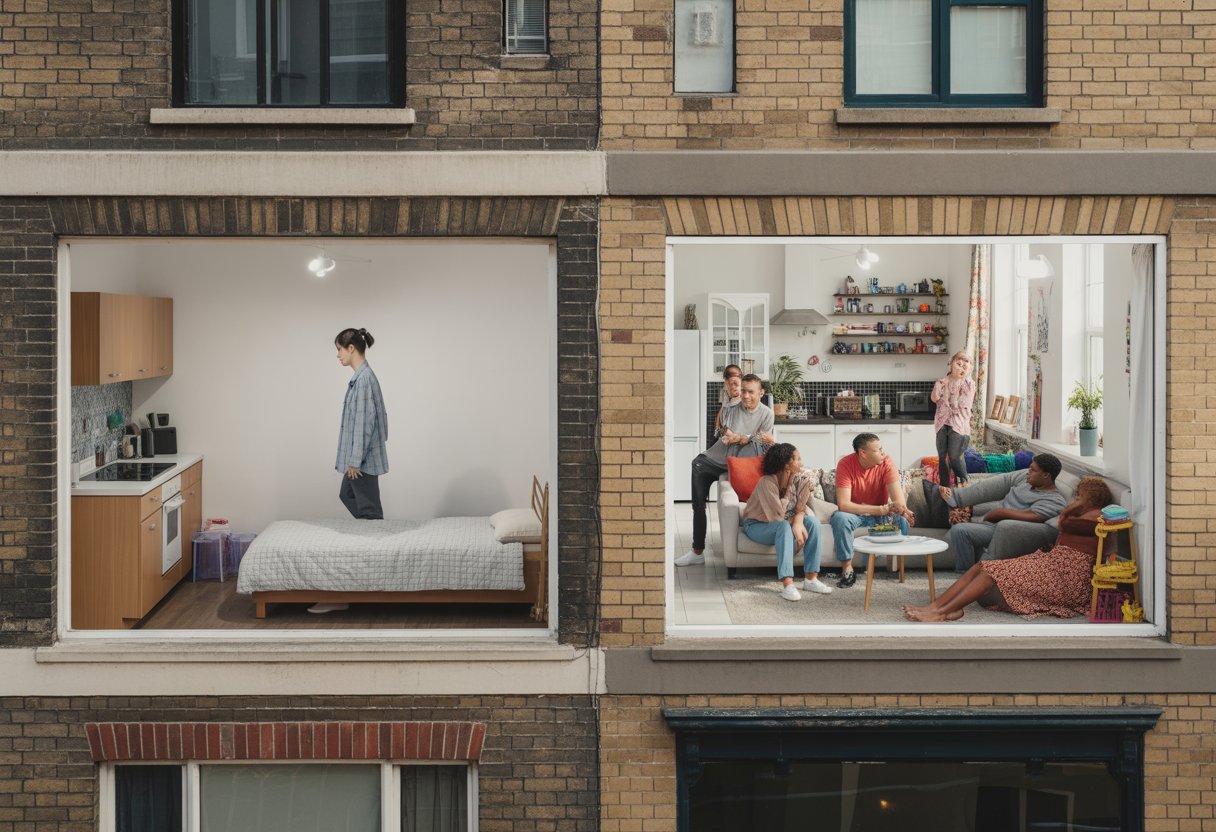Living alone in the UK can feel like the ultimate freedom, but it often comes with a higher price tag. Flatsharing, on the other hand, offers a way to cut costs and still have a comfortable place to live. The real cost difference between living alone and flatsharing shows that flatsharing can save hundreds of pounds each month, mainly through shared bills and rent.

People who choose to live alone pay for everything by themselves, including rent, utilities, and council tax, which quickly adds up. Flatsharers split most of these expenses, making it a more affordable option, especially in cities where rent tends to be very high.
This post breaks down the main costs for both options to show exactly where the money goes. Knowing these details can help anyone make a smarter choice about their living situation.
Direct Costs of Living Alone Versus Flatsharing

Living alone usually means paying the full cost of rent, bills, council tax, and other essential fees. Flatsharing spreads some of these costs across housemates, making individual expenses generally lower. However, the exact difference varies depending on location and type of property.
Rent Comparison
Rent is often the largest monthly expense. When living alone, individuals pay the entire rent themselves, which in cities like London can be over £1,200 per month for a one-bedroom flat.
In a flatshare, the rent is divided among the tenants. For example, sharing a three-bedroom flat with others might cost each person around £600 to £800 monthly, depending on the area.
This means flatsharing can reduce rent costs by nearly half or more, especially in expensive regions. However, some prefer the privacy and space that come with living alone, despite the higher rent.
Utility Bills
Utility bills include gas, electricity, and water. Living alone means paying the full amount of these bills, which can add around £70 to £120 monthly, depending on usage and property size.
In flatshares, utility bills are usually split. Each tenant typically pays a share of the total, often around £20 to £40 per month, which lowers individual costs.
Sometimes, flatshares include utility bills within a set monthly fee. This can simplify payments, but tenants should check what is covered before agreeing.
Council Tax Differences
Council tax depends on the property band and number of occupants. People living alone may qualify for a 25% single person discount on their council tax bill.
Flatshares do not get this discount because multiple adults live in the property. Thus, the full council tax rate applies and is divided among tenants.
For instance, a Band C property might have a total council tax of £1,500 annually. A single occupant pays about £1,125 after the discount, while flatsharers split the full £1,500, reducing their share.
Internet and TV Licence Fees
Internet costs can range from £25 to £40 per month, regardless of living alone or flatsharing. Sharing the cost among flatmates lowers the individual fee.
A TV licence costs £159 per year and is required for each household, not person. Flatshares pay one licence for the property; the cost is split among residents.
For a single occupant, this licence is a full annual cost. In shared housing, dividing the licence fee and internet bill reduces monthly expenses linked to connectivity and TV.
Upfront and Ongoing Expenses

Living alone or flatsharing both come with costs that start before moving in and continue every month. These include deposits, buying or sharing furniture, and handling repairs or maintenance. Each choice has different financial demands that affect the overall budget.
Deposits and Initial Moving Costs
When renting, tenants usually pay a deposit equal to 4-6 weeks’ rent. For someone living alone, this deposit is entirely their responsibility. In a flatshare, the deposit is often shared, lowering individual upfront costs.
Moving costs include hiring a van or a removal service. Alone, all these expenses fall on one person. Flatsharers can split the costs, reducing the amount each pays. Utility setup fees might apply in either case, but alone they are paid fully by one tenant, while flatsharers can share or avoid some charges.
Furnishing and Household Appliances
A person living alone must furnish an entire home, including beds, tables, sofas, and kitchen appliances. This can cost from £1,000 to £3,000 depending on quality and item quantity.
Flatsharers often find rooms already furnished or share items like fridges and microwaves. This lowers the initial investment. Shared costs for replacing or repairing common appliances also reduce individual spending.
Ongoing Maintenance and Repairs
Living alone means covering all repair and maintenance costs unless the landlord pays for them. This includes fixing heating, plumbing, or appliances.
In flatshares, residents may share some upkeep tasks or costs. However, damage caused by one person might affect everyone’s bills. Regular cleaning and minor repairs can also be shared to reduce costs and effort.
| Expense Type | Living Alone | Flatsharing |
|---|---|---|
| Deposit | Full cost upfront | Shared among flatmates |
| Moving Costs | Paid individually | Shared |
| Furnishing | Full purchase needed | Often shared or provided |
| Appliance Repairs | Sole responsibility | Shared responsibility |
Hidden Financial Implications

Living alone and flatsharing both come with costs that might not be obvious at first. These include factors like insurance, food shopping habits, and additional charges that landlords might apply based on how many people live in a property.
Insurance Considerations
When living alone, individuals often face higher home insurance prices. Insurance companies consider detached living riskier because there is no one else to help prevent damage or theft. This can mean paying up to 30% more compared to a shared flat.
In contrast, flatsharers usually pay less per person on insurance. This is because risk is spread across multiple tenants, and shared properties are often seen as less likely to be targeted.
Building insurance is normally included by landlords, but contents insurance is essential for tenants. Living alone means covering all personal belongings on one policy, which can be pricier than splitting the cost.
Food and Essential Shopping
People living alone usually spend more on food per person. Buying smaller amounts often costs more per unit, and ingredients can go to waste. For example, fresh vegetables bought weekly might spoil before use, leading to wastage and higher overall spend.
Flatsharing allows for shared meals and bulk buying. Tenants can buy large packs of essentials like rice, pasta, and frozen goods, reducing individual costs. Housemates often split the cost of common items such as cleaning supplies successfully.
However, some flatsharers might face conflicts about food sharing or eating patterns, making personal budgeting necessary.
Single Occupancy Premiums
Landlords sometimes charge a single occupancy premium when renting to one person in a property intended for multiple tenants. This increase covers risks like longer vacancy periods and fewer rent payments.
In many UK cities, this premium can add £20 to £50 per month to the rent. It may also appear as higher utility bills because fixed costs are not shared.
Flatsharers avoid these premiums because the rent is split evenly. More tenants also tend to mean lower bills per person, making flatsharing more cost-effective in many cases.
Social and Lifestyle Trade-Offs

Living alone or flatsharing affects more than just finances. It changes daily routines, personal space, and social life in clear ways.
Privacy and Independence
Living alone gives full control over the home. People can set their own rules, decorate as they like, and enjoy quiet without interruptions.
This level of independence suits those who value their space and privacy highly. There are no compromises on noise, cleanliness, or visitors.
In flatshares, privacy is limited. Shared areas like the kitchen and bathroom mean regular interaction and negotiation.
Residents must often adapt to others’ schedules and habits. This can reduce personal freedom but may offer a sense of belonging.
Community and Networking Opportunities
Flatsharing creates built-in social opportunities. Housemates often become friends and share daily experiences.
This can help reduce feelings of loneliness and provide support, especially in big cities where moving alone is common.
It also offers chances to network with different people, which can be useful for work or social life.
Living alone can be isolating. It requires more effort to meet new people or join communities.
Social life depends on external activities, like clubs or work, rather than home life.
Impact on Work-Life Balance
Flatsharing may complicate work-from-home situations. Noise and shared spaces can disrupt focus and increase stress.
Some flatshares offer quiet areas, but this varies widely by household.
Living alone provides a quieter environment that can improve concentration and productivity.
However, managing all household tasks alone can add to personal stress, affecting free time.
Flatsharers often share chores, which can ease daily routines and free up time for leisure.
Strategies to Manage Costs Effectively
Managing living costs well requires careful planning, knowing available financial help, and being proactive in dealing with landlords. These steps help reduce expenses and make budgeting easier for those living alone or flatsharing.
Budgeting and Financial Planning
Creating a detailed budget is essential. This means listing all income sources and fixed expenses, such as rent, bills, and food. Tracking variable costs like entertainment helps spot where money might be saved.
Using budgeting apps or simple spreadsheets can keep finances organised. Setting spending limits and checking monthly bills helps avoid surprises. It is also useful to plan for irregular costs like repairs or annual services.
Prioritising essential costs before luxuries prevents overspending. Regular budgeting reviews allow adjustments if income or expenses change. This habit supports better financial control over time.
Utilising Government Schemes and Support
Many people miss out on financial aid that can lower living costs. In the UK, schemes like Universal Credit or Housing Benefit offer help with rent and bills for eligible individuals.
Council Tax Reduction is another key support for lower-income residents. Applying early ensures quicker access to funds. Some local authorities also provide grants for energy bills or food costs.
Checking eligibility for schemes can be done online or at local offices. Keeping documents organised speeds up the application process. These supports can make a notable difference in affordability.
Negotiating Rental Agreements
Rent is often the biggest expense. Tenants can ask landlords for lower rent, especially if the market has many available properties. Offering to sign a longer lease might encourage discounts.
Discussing bill inclusions, such as water or internet, can also save money. Sometimes landlords agree to cover certain utilities if tenants pay a slightly higher rent.
Clear communication and polite negotiation improve chances. Tenants should research comparable rents in the area to support their requests. Written agreements after negotiation ensure both sides understand the terms.

